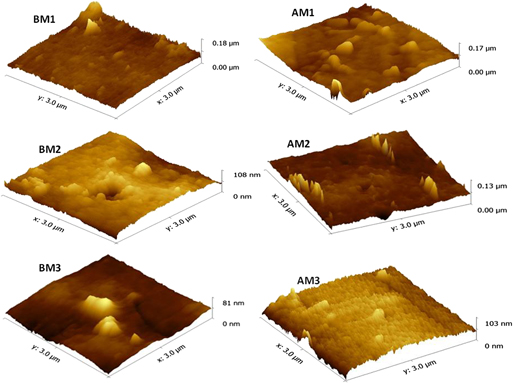Crossref Citations
This article has been cited by the following publications. This list is generated based on data provided by
Crossref.
Jyothi, M.S.
Nayak, Vignesh
Padaki, Mahesh
Geetha Balakrishna, R.
and
Ismail, A.F.
2014.
The effect of UV irradiation on PSf/TiO2 mixed matrix membrane for chromium rejection.
Desalination,
Vol. 354,
Issue. ,
p.
189.
Nayak, Vignesh
Jyothi, Mannekote Shivanna
Balakrishna, R. Geetha
Padaki, Mahesh
and
Ismail, Ahmad Fauzi
2015.
Preparation and Characterization of Chitosan Thin Films on Mixed-Matrix Membranes for Complete Removal of Chromium.
ChemistryOpen,
Vol. 4,
Issue. 3,
p.
278.
Afzal, Anam
Kausar, Ayesha
and
Siddiq, Muhammad
2016.
A Review on Polymer/Cement Composite with Carbon Nanofiller and Inorganic Filler.
Polymer-Plastics Technology and Engineering,
Vol. 55,
Issue. 12,
p.
1299.
Li, Tingting
Zhang, Zhiming
Li, Wei
Liu, Ce
Zhou, Haoyu
and
An, Libao
2016.
Electrospinning preparation, characterization, and enhanced photocatalytic activity of an Silicotungstic acid (H4SiW12O40)/poly(vinyl alcohol)/poly(methyl methacrylate) composite nanofiber membrane.
Journal of Applied Polymer Science,
Vol. 133,
Issue. 11,
Ozay, Yasin
Dizge, Nadir
Gulsen, Habibe Elif
Akarsu, Ceyhun
Harputlu, Ersan
Ozer, Erman
Unyayar, Ali
and
Ocakoglu, Kasim
2016.
Investigation of Electroactive and Antibacterial Properties of Polyethersulfone Membranes Blended With Copper Nanoparticles.
CLEAN – Soil, Air, Water,
Vol. 44,
Issue. 8,
p.
930.
Nayak, Vignesh
Jyothi, M. S.
Balakrishna, R. Geetha
Padaki, Mahesh
and
Isloor, Arun M.
2016.
Synthesis and characterization of novel sulfanilic acid–polyvinyl chloride–polysulfone blend membranes for metal ion rejection.
RSC Advances,
Vol. 6,
Issue. 30,
p.
25492.
M.S., Jyothi
Nayak, Vignesh
Padaki, Mahesh
and
Balakrishna, R. Geetha
2017.
Sunlight active PSf/TiO 2 hybrid membrane for elimination of chromium.
Journal of Photochemistry and Photobiology A: Chemistry,
Vol. 339,
Issue. ,
p.
89.
M.S., Jyothi
Nayak, Vignesh
Padaki, Mahesh
Balakrishna, R. Geetha
and
Soontarapa, Khantong
2017.
Eco-friendly membrane process and product development for complete elimination of chromium toxicity in wastewater.
Journal of Hazardous Materials,
Vol. 332,
Issue. ,
p.
112.
Kazemi, Maryamossadat
Jahanshahi, Mohsen
and
Peyravi, Majid
2018.
Hexavalent chromium removal by multilayer membrane assisted by photocatalytic couple nanoparticle from both permeate and retentate.
Journal of Hazardous Materials,
Vol. 344,
Issue. ,
p.
12.
Kuvarega, Alex T.
Khumalo, Nomcebo
Dlamini, Derrick
and
Mamba, Bhekie B.
2018.
Polysulfone/N,Pd co-doped TiO2 composite membranes for photocatalytic dye degradation.
Separation and Purification Technology,
Vol. 191,
Issue. ,
p.
122.
Alias, Nur Hashimah
Jaafar, Juhana
Samitsu, Sadaki
Matsuura, T.
Ismail, A.F.
Othman, M.H.D.
Rahman, Mukhlis A.
Othman, Nur Hidayati
Abdullah, Norfazliana
Paiman, Syafikah Huda
Yusof, N.
and
Aziz, F.
2019.
Photocatalytic nanofiber-coated alumina hollow fiber membranes for highly efficient oilfield produced water treatment.
Chemical Engineering Journal,
Vol. 360,
Issue. ,
p.
1437.
Koli, Mitil M.
and
Singh, Swatantra P.
2023.
Surface-modified ultrafiltration and nanofiltration membranes for the selective removal of heavy metals and inorganic groundwater contaminants: a review.
Environmental Science: Water Research & Technology,
Vol. 9,
Issue. 11,
p.
2803.
Pusphanathan, Kavita
Shukor, Hafiza
Shoparwe, Noor Fazliani
Makhtar, Muaz Mohd Zaini
Zainuddin, Nor’ Izzah
Jullok, Nora
Siddiqui, Masoom Raza
Alam, Mahboob
and
Rafatullah, Mohd
2023.
Efficiency of Fabricated Adsorptive Polysulfone Mixed Matrix Membrane for Acetic Acid Separation.
Membranes,
Vol. 13,
Issue. 6,
p.
565.
Pusphanathan, Kavita
Shukor, Hafiza
Shoparwe, Noor Fazliani
Makhtar, Muaz Mohd Zaini
Zainuddin, Nor’ Izzah
and
Jullok, Nora
2023.
Emerging Technologies for Future Sustainability.
p.
161.
Ranjbaran, Hamed
Ameri, Elham
and
Dehghani, Babak
2024.
Preparation of dendrimer/TiO2 polysulfone nanofiltration membrane to improve antibacterial, antifouling and separation performance of contaminants (heavy metals, salts, dyes).
Polymer Bulletin,
Vol. 81,
Issue. 2,
p.
1471.
Cardoso, Andreza P.
Giacobbo, Alexandre
Bernardes, Andréa M.
and
Ferreira, Carlos A.
2024.
Performance evaluation of polysulfone-based membranes produced with a green solvent.
Journal of Materials Research,
Vol. 39,
Issue. 10,
p.
1525.
Pusphanathan, Kavita
Mohd Zaini Makhtar, Muaz
Shukor, Hafiza
Mohd Sabri, Muhammad Najib Ikmal
Abdul Rasik, Nur Atiqah
Shamsuddin, Nurul Atiqah
Siddiqui, Masoom Raza
Kapoor, Riti Thapar
and
Rafatullah, Mohd
2024.
Effectiveness of Direct Sulfonated Polysulfone in Dual Chamber Microbial Fuel Cells Based Dewatered Sludge for Power Generation.
International Journal of Environmental Research,
Vol. 18,
Issue. 6,
Umar, Khalid
Afridi, Saima Khan
and
Iqbal, Anwar
2024.
Advanced Materials for Emerging Water Pollutant Removal.
p.
178.
Shetty, Mahesh Kumar
Patil, Jagadish H.
Shekhar, S. Murthy
Hiremath, Poornima G.
Rajani, M.R.
Desai, S.M.
and
Prashantha, K.
2024.
Immobilized chitosan as an efficient adsorbent for columnar adsorption of Cr (VI) from aqueous solution.
International Journal of Biological Macromolecules,
Vol. 282,
Issue. ,
p.
137445.



